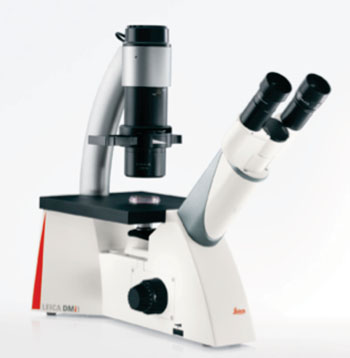New Inverted Microscope Available for Routine Work and Training
By LabMedica International staff writers
Posted on 26 Jun 2014
A robust inverted light microscope for quick cell culture checking and other routine work is now available for biotech, life science, and clinical laboratories.Posted on 26 Jun 2014
The Leica Microsystems (Wetzlar, Germany) Leica DMi1 inverted microscope enables the user to check and document cell and tissue cultures within seconds. Its ease-of-use and efficient operation make it an excellent choice for routine laboratory work as well as for training.

Image: The Leica DMi1 inverted microscope enables cell biologists to check and document cell and tissue cultures within seconds. Its ease-of-use and efficient operation make it an excellent choice for routine laboratory work as well as for training (Photo courtesy of Leica Microsystems).
The Leica DMi1 is extremely stable due to its low center of gravity. The use of high-grade materials—almost exclusively metal—also helps avoid vibrations and resulting image blur. A scratch-resistant stage, high quality optical components, and a wide range of accessories promote a long product life with low maintenance costs.
The microscope incorporates several innovations that make routine applications easier. For example, phase contrast observation is simplified, as the 10x, 20x, and 40x objectives share the same light ring, which means that the user no longer needs to match light rings and objectives. Furthermore, an intelligent sensor automatically adjusts light intensity between brightfield and phase contrast method-switching. The 40 to 50 or 80 millimeter working distance allows a wide variety of culture containers including flasks, dishes, or multiwell plates to be used on the fixed stage. An optional object guide with different kinds of holding frames is available to securely and reliably hold and move laboratory vessels during observation and documentation.
To ease documentation a configuration of the microscope with digital camera connected to the integrated C-mount is available. The camera is mounted at the back of the stand, and no additional trinocular tube is needed. The camera, which is available with either 2.5 or 5.0 megapixels resolution, captures images and videos and is operated via remote control or palm/foot switch. Data can be stored directly on an SD card or on a computer. Alternatively, images can be displayed directly on an HDMI screen connected via an HDMI port. The core version of Leica Application Suite (LAS) software for PC is included with the system, so that users can refine their image analysis with measurements and annotations.
Leica Microsystems product manager Yana Zhou said, “With the Leica DMi1, Leica Microsystems facilitates routine cell culture work with an easy-to-use, fast, and reliable tool for a budget-friendly price. At the same time, users are provided with the image quality and robust design they expect from a Leica microscope”.
Related Links:
Leica Microsystems








 (3) (1).png)





